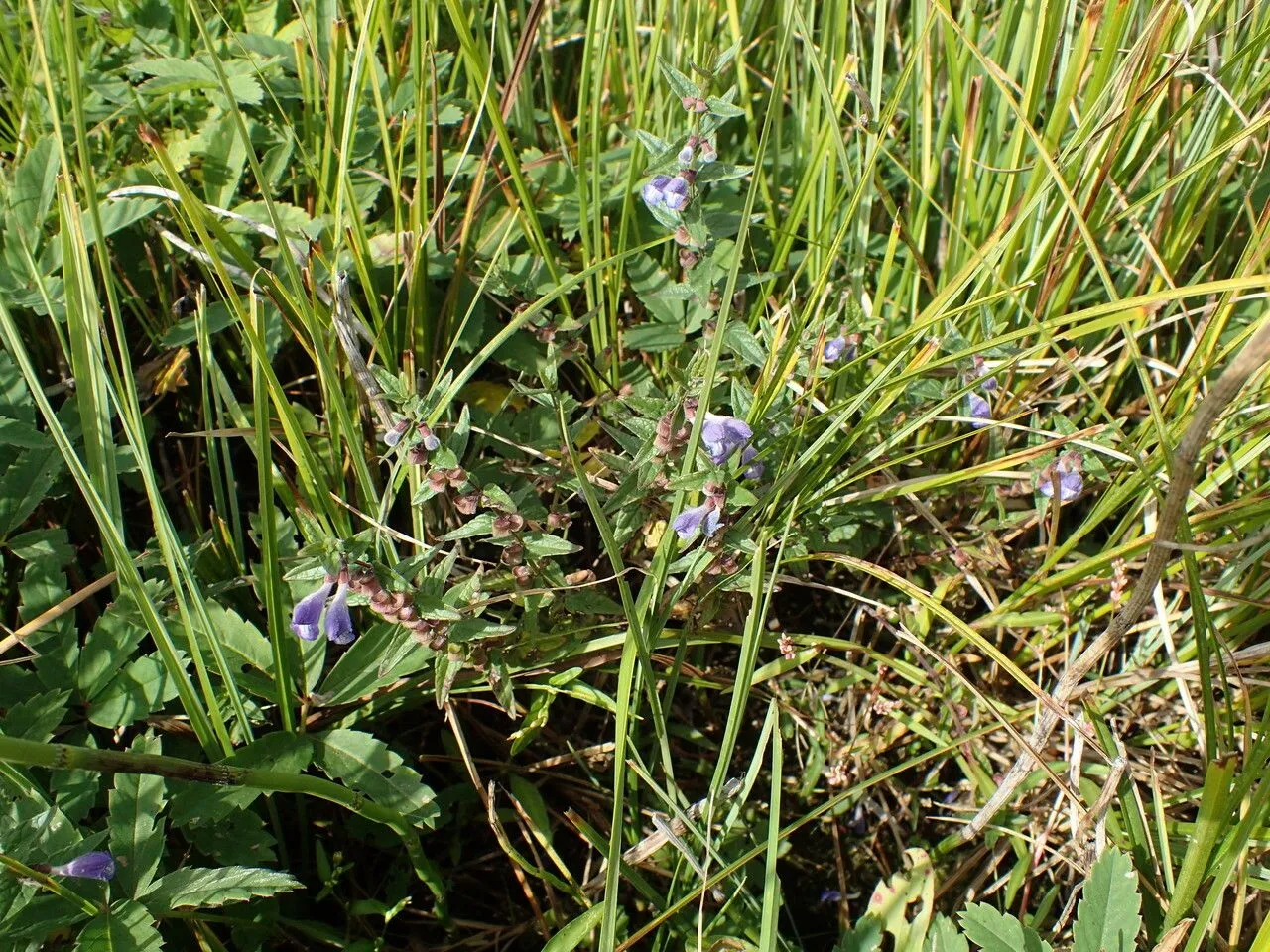
Author: L.
Bibliography: Sp. Pl.: 599 (1753)
Year: 1753
Status: accepted
Rank: species
Genus: Scutellaria
Vegetable: False
Observations: Temp. Northern Hemisphere
Marsh Skullcap, scientifically known as Scutellaria galericulata, is a fascinating perennial herb that graces the temperate regions of the Northern Hemisphere with its presence. Described by the renowned botanist Carl Linnaeus in his seminal work Species Plantarum in 1753, this plant is a member of the Lamiaceae family, commonly known as the mint or deadnettle family.
In its natural habitat, the Marsh Skullcap prefers wet environments such as marshes, fens, and the edges of ponds and streams. This affinity for moist soil conditions makes it a common sight in wetlands, where it thrives amidst the lush, waterlogged flora. Its geographical distribution spans a wide range across the Northern Hemisphere, stretching from North America to Europe and parts of Asia. This broad distribution attests to its adaptability to different temperate climates and various ecological niches within these regions.
The plant features characteristic square stems, a hallmark of the Lamiaceae family, and can reach heights of up to 60 centimeters (about 24 inches). The leaves are typically lance-shaped, serrated, and borne in opposite pairs along the stem, contributing to its distinctive and easily recognizable appearance. During its blooming period, which generally occurs from June to September, Marsh Skullcap produces beautiful, tubular flowers that possess a charming bluish-purple hue. These flowers attract a myriad of pollinators, including bees and butterflies, playing a crucial role in the ecosystem by promoting pollination and maintaining biodiversity.
Marsh Skullcap has been studied for its potential medicinal properties. Various cultures have used different species within the Scutellaria genus for their purported health benefits, which range from anti-inflammatory and sedative effects to treatments for anxiety and insomnia. However, it is essential to approach its use with caution and consult with healthcare professionals due to the specific biochemical properties and potential side effects associated with its active compounds.
In summary, Marsh Skullcap (Scutellaria galericulata) is not only valued for its ecological contributions and aesthetic appeal but also holds a place of interest in ethnobotany and herbal medicine. Its widespread presence across the Northern Hemisphere reinforces its status as an integral component of wetland ecosystems, providing essential services to both wildlife and humans.
Dan: almindelig skjolddrager
Eng: hooded skullcap, marsh scullcap, marsh skullcap, skullcap
Deu: sumpf-helmkraut, sumpfhelmkraut, sumpf helmkraut
Nld: blauw glidkruid
Swe: frossört, luhtavuohennokka, getnos, vanlig frossört
Fin: luhtavuohennokka
Fra: scutellaire casquée, scutellaire toque, grande toque, scutellaire à casque, scutellaire à grande fleur, tertianaire
Nno: skjoldberar
Nob: skjoldbærer
Sme: gáiccanjunni
Cym: cap nos tadcu, cwcwll, cycyll-lys, cycyll-lys mwyaf, cycyllog, cycyllog mwyaf
En: Marsh scullcap, Skullcap, Marsh skullcap, Hooded Skullcap, Common scullcap, Common Skullcap
Ar: هربون مقلنس
Be: Шлёмнік звычайны
Bg: Обикновена превара
Ca: Escutel·lària
Zh: 盔状黄芩
Cs: Šišák vroubkovaný
Da: Almindelig Skjolddrager
Nl: Blauw glidkruid
Et: Harilik tihashein
Fi: Luhtavuohennokka, Vuohennokka
Fr: Scutellaire casquée, Grande toque, Scutellaire a casque, Scutellaire à casque, Scutellaire toque, Scutellaire à grande fleur, Tertianaire, Herbe judaïque, Trétianaire
De: Sumpf Helmkraut, Gewöhnliches Helmkraut, Sumpf-Helmkraut, Sumpfhelmkraut, Kappen-Helmkraut
He: קערורית הביצה
It: Scutellaria palustre, Scutellaia comune
Lt: Pelkinė kalpokė
Se: Gáiccanjunni
No: Skjoldberar
Nb: Skjoldbærer
Nn: Skjoldberar
Fa: بشقابی معمولی
Pl: Tarczyca pospolita
Ru: Шлемник обыкновенный
Sk: Šišak vrúbkovaný
Es: Navadna čeladnica, Canina, Casida, Escutelaria común, Escutelaria, Hierba de la celada, Tercianaria, Terciaria, Yerba de la celada
Sv: Frossört, Getnos, Luhtavuohennokka, Vanlig frossört
Uk: Шоломниця звичайна
Cy: Cycyllog, Cap Nos Tadcu, Cwcwll, Cycyll-Lys, Cycyll-Lys Mwyaf, Cycyllog Mwyaf
Taken Sep 6, 2020 by Sylvain Piry (cc-by-sa)
Taken Feb 13, 2022 by Jan Unruh (cc-by-sa)
Taken Jun 22, 2022 by Stephane Eduardo De Oliveira (cc-by-sa)
Taken Sep 7, 2021 by Pierre LEON (cc-by-sa)
Taken Jun 8, 2016 by Henk Van Lottum (cc-by-sa)
Taken Sep 6, 2020 by Sylvain Piry (cc-by-sa)
Taken Sep 6, 2020 by Sylvain Piry (cc-by-sa)
Taken May 22, 2021 by keiko ohashi (cc-by-sa)
Taken Sep 8, 2021 by Sylvain Piry (cc-by-sa)
Taken Sep 7, 2021 by Pierre LEON (cc-by-sa)
Taken Jul 2, 2014 by Tela Botanica − Quentin LEBASTARD (cc-by-sa)
Taken Jul 5, 2014 by Tela Botanica − LE ROY Jean-Pierre (cc-by-sa)
Taken Aug 13, 2022 by Waldemar Zeja (cc-by-sa)
Taken Sep 8, 2021 by Sylvain Piry (cc-by-sa)
Taken Sep 8, 2021 by Sylvain Piry (cc-by-sa)
Taken Aug 29, 2021 by hieracium eriophorum (cc-by-sa)
Taken Aug 13, 2022 by Waldemar Zeja (cc-by-sa)
Taken Sep 6, 2020 by Sylvain Piry (cc-by-sa)
Taken Sep 7, 2021 by Pierre LEON (cc-by-sa)
Taken Sep 8, 2021 by Sylvain Piry (cc-by-sa)
© copyright of the Board of Trustees of the Royal Botanic Gardens, Kew.
© copyright of the Board of Trustees of the Royal Botanic Gardens, Kew.
© copyright of the Board of Trustees of the Royal Botanic Gardens, Kew.
Taken Sep 13, 2020 by Maarten Vanhove (cc-by-sa)
Taken Jun 26, 2022 by Tristan Jaton-Maria (cc-by-sa)
Taken Jun 18, 2016 by huy HO (cc-by-sa)
Taken Aug 9, 2014 by Tela Botanica − John DE VOS (cc-by-sa)
Taken Sep 7, 2021 by Pierre LEON (cc-by-sa)
Taken Oct 20, 2012 by Tela Botanica − Marie PORTAS (cc-by-sa)
Taken Sep 1, 2019 by Tim Konsul (cc-by-sa)
Taken Jul 4, 2017 by Jose Luis Romero (cc-by-sa)
Taken Sep 13, 2020 by Maarten Vanhove (cc-by-sa)
Taken May 25, 2021 by catherine white (cc-by-sa)
Growth habit: Forb/herb
Ph maximum: 7.0
Ph minimum: 6.5
Light: 7
Atmospheric humidity: 9
Bloom months: [‘jun’, ‘jul’, ‘aug’, ‘sep’]
Soil nutriments: 6
Family: Myrtaceae Author: (F.Muell.) K.D.Hill & L.A.S.Johnson Bibliography: Telopea 6: 402 (1995) Year: 1995 Status:…
Family: Rubiaceae Author: Pierre ex A.Froehner Bibliography: Notizbl. Bot. Gart. Berlin-Dahlem 1: 237 (1897) Year:…
Family: Sapindaceae Author: Koidz. Bibliography: J. Coll. Sci. Imp. Univ. Tokyo 32(1): 38 (1911) Year:…
Family: Asteraceae Author: A.Gray Bibliography: Pacif. Railr. Rep.: 107 (1857) Year: 1857 Status: accepted Rank:…
Family: Fabaceae Author: Medik. Bibliography: Vorles. Churpfälz. Phys.-Ökon. Ges. 2: 398 (1787) Year: 1787 Status:…
Family: Aspleniaceae Author: (Cav.) Alston Bibliography: Bull. Misc. Inform. Kew 1932: 309 (1932) Year: 1932…